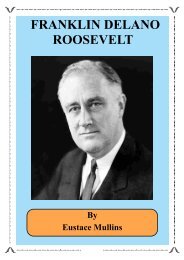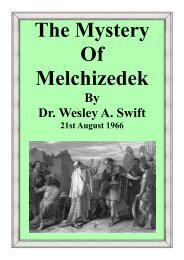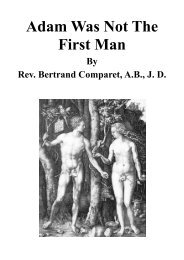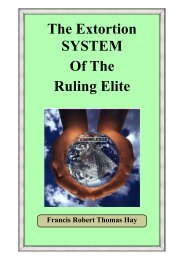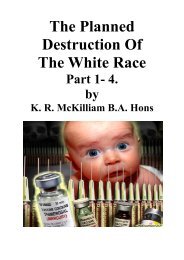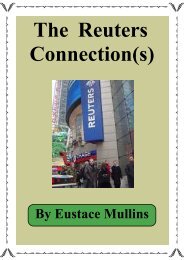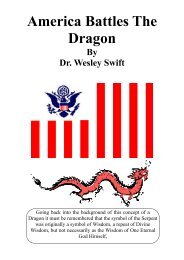Curse of Cannan - The New Ensign
Curse of Cannan - The New Ensign
Curse of Cannan - The New Ensign
Create successful ePaper yourself
Turn your PDF publications into a flip-book with our unique Google optimized e-Paper software.
and lead them to the old bathhouse to a booth lined with three or four layers <strong>of</strong> blankets inside.<br />
<strong>The</strong>re the condemned prisoners were ordered to undress in the snow and enter the bath naked.<br />
Inside, they were shot with pistols. In the course <strong>of</strong> one and a half months about two hundred<br />
persons were destroyed in this way. <strong>The</strong> corpses were burned in the tundra."<br />
Solzhenitsyn continues, "A. B. ______v has told how executions were carried out at Adak--a<br />
camp on the Pechora River. <strong>The</strong>y would take the opposition members 'with their things' out <strong>of</strong><br />
the camp compound on a prisoner transport at night. And outside the compound stood the small<br />
house <strong>of</strong> the Third Section. <strong>The</strong> condemned men were taken into a room one at a time, and there<br />
the camp guards sprang on them. <strong>The</strong>ir mouths were stuffed with something s<strong>of</strong>t and their arms<br />
were bound with cords behind their backs. <strong>The</strong>n they were led out into the courtyard, where<br />
harnessed carts were waiting. <strong>The</strong> bound prisoners were piled on the carts, from five to seven at<br />
a time, and driven <strong>of</strong>f to the 'Gorka,' the camp cemetery. On arrival they were tipped into big<br />
pits that had already been prepared and buried alive. No, not out <strong>of</strong> brutality. It has been<br />
ascertained that when dragging and lifting them, it was much easier to cope with living people<br />
than with corpses. <strong>The</strong> work went on for many nights at Adak."<br />
Solzhenitsyn is not the only person to describe life in the Soviet concentration camps. Consider<br />
the following description <strong>of</strong> life in a gulag: Sergei Grigoryants says that the prisoners are<br />
awakened at 5:30 a.m. and served a watery fish soup and brown bread for breakfast; at 10:30<br />
the main meal, which is watery soup; the dinner is porridge. Grigoryants says that the prisoners<br />
are constantly tortured through lack <strong>of</strong> food and the cold in the cells. Soviet law requires that the<br />
temperature in the cells be at least 64.4 degrees Fahrenheit; this is solemnly tested by the camp<br />
inspectors. <strong>The</strong>y bring an electric heater into the cell, turn it on until the temperature reaches<br />
64.4 degrees, make the appropriate notation on their report, and then take the heater to the next<br />
cell. <strong>The</strong> temperature then returns to its usual forty degrees. A lamp is kept constantly burning<br />
all night in the cells, so that the prisoners never really rest. Grigoryants says that some 500,000<br />
prisoners a year are released to return to Soviet society, and that their presence has a very alarming<br />
effect upon the entire country. Here again, how pertinent is this report? It was published as an<br />
interview with Grigoryants in the <strong>New</strong> York Times <strong>of</strong> February 22, 1987!<br />
It would be logical to suppose that this Socialist society was built on the confiscated fortune <strong>of</strong><br />
the late Czar Nicholas II, but this is not the case. In 1913, the Czar was undoubtedly the richest<br />
man in the world, with a personal fortune amounting to some thirty billion dollars in 1913 dollars.<br />
He personally owned 150,000,000 acres <strong>of</strong> land, and had some 30,000 servants, 500 automobiles<br />
in his personal fleet, 6,000 horses, 2 yachts, a personal gold reserve <strong>of</strong> one billion dollars in the<br />
Imperial Bank, with five hundred million dollars worth <strong>of</strong> jewels, including the $200,000 Great<br />
Mogul diamond, a Crown valued at $75 million and 32,000 diamonds. He controlled one-sixth<br />
<strong>of</strong> the surface <strong>of</strong> the entire globe. On the night <strong>of</strong> November 6, 1917, at 2:00 a.m., Red Guards<br />
drove a truck to the Imperial Bank and removed all <strong>of</strong> the Roman<strong>of</strong>f gold and jewels. Much <strong>of</strong><br />
the gold was later shipped directly to Kuhn, Loeb Co. in <strong>New</strong> York. We may recall that the senior<br />
partner <strong>of</strong> Kuhn, Loeb Co., Jacob Schiff, had put up some $20 million <strong>of</strong> his own funds to finance<br />
the Revolution. Apparently it was a good investment. Victor Hammer fenced many <strong>of</strong> the Crown<br />
jewels to collectors in Europe and the United States.<br />
<strong>The</strong> Dowager Empress Maria escaped with the considerable jewels in her personal collection.<br />
Both King George V and King Christian <strong>of</strong> Denmark repeatedly tried to get her to "entrust" her<br />
jewels to them for "safekeeping" or at least for" appraisal." She steadfastly refused, knowing<br />
that she probably would never see them again. When she died in 1928, special agents seized the<br />
jewels and immediately whisked them to Buckingham Palace. Her more important pieces later<br />
were seen in Queen Mary's personal collection.<br />
After the Revolution <strong>of</strong> 1905, the Czar had prudently prepared for further outbreaks by<br />
transferring some $400 million in cash to the <strong>New</strong> York banks, Chase, National City, Guaranty<br />
Trust, J. P. Morgan Co., and Hanover Trust. In 1914, these same banks bought the controlling<br />
( Page 108)



